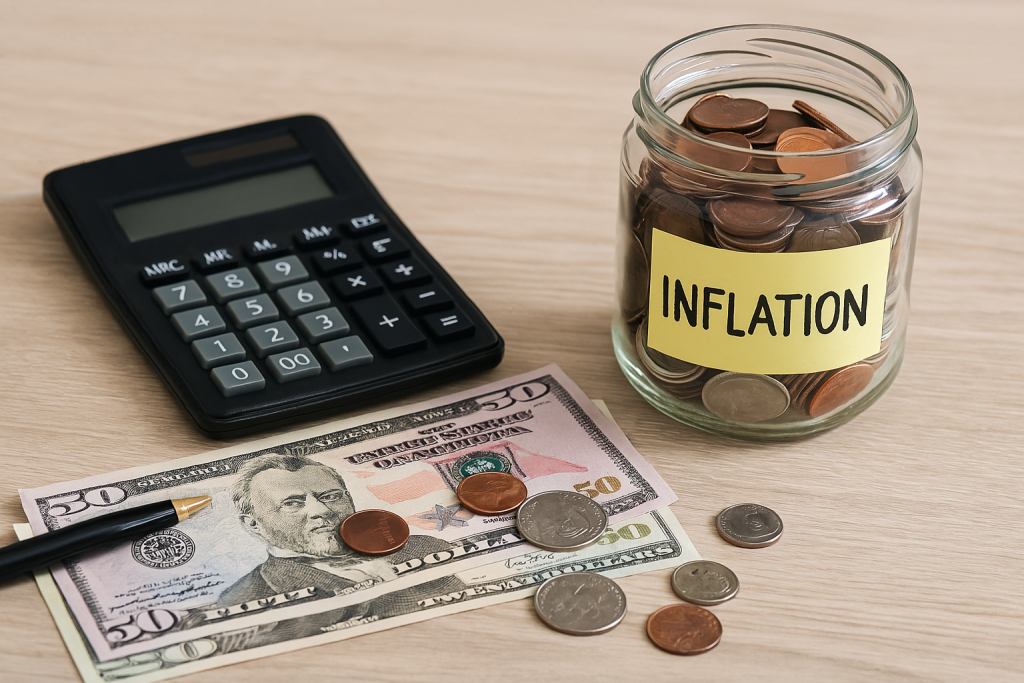It’s frustrating when your paycheck feels like it’s stuck, but everything else keeps getting more expensive. That feeling is called inflation, and it’s a problem we all face. It quietly eats away at your buying power, turning everyday purchases into bigger challenges as prices rise.
Inflation isn’t just an issue for economists—it impacts everyone, in every part of their life. It touches the food you buy, the rent you pay, and even the savings you’re trying to build. In this guide, we’ll talk about how inflation works and share ways to protect your money so you don’t lose ground as prices rise.
What is inflation and how does it affect your money?

Inflation is the steady increase in the price of goods and services, meaning your money buys less over time. What used to cost $100 now costs $110 or more. It doesn’t matter if your salary stays the same—the value of what you can buy with it decreases, making it harder to maintain your lifestyle.
Inflation can be caused by many things, such as higher demand, supply shortages, or even changes in government policies. Its effects are felt in many ways, from higher grocery bills to rising transportation costs.
How inflation reduces your purchasing power day by day
If you’ve noticed that the same groceries cost more than they used to, you’re seeing inflation in action. Over time, even small price hikes can add up, making it harder to buy the things you need, especially when your salary doesn’t keep pace with rising costs.
This doesn’t just affect food—it touches almost every aspect of your life. Housing, healthcare, and transportation costs can all rise with inflation, leaving you with less money to save or invest. Without careful management, inflation can start to feel like a constant battle against your finances.
Spotting signs of inflation in everyday life
You’ll likely notice inflation most clearly when everyday essentials go up in price. Whether it’s food, gas, or utility bills, rising prices can start to feel like a regular part of your life. If your income doesn’t rise in line with inflation, you’ll notice how much harder it is to keep up.
Another sign of inflation is “shrinkflation,” where products get smaller but the price stays the same. You might not see it at first, but the value you get for your money is shrinking, even if the price tag looks the same.
The impact on salaries and savings
Even though wages go up sometimes, they often don’t rise fast enough to keep up with inflation. If you get a raise of 3% but inflation rises 5%, your real income has gone down. This means that even if you’re earning more, your purchasing power is shrinking, making it harder to maintain the same standard of living. Your savings also lose value over time if they’re not growing faster than inflation.
Strategies to protect your money from inflation
Fighting inflation is all about being proactive and making smart choices with your money. You can’t control inflation, but you can control how you respond to it. By planning ahead and making informed decisions, you can protect your wealth and keep your financial goals intact.
The key is to adjust your habits, invest wisely, and make sure your money is working for you. The sooner you act, the better you’ll be at preserving your purchasing power and growing your wealth, despite rising prices.
Investments that shield against inflation
One of the best ways to protect your money is by investing in inflation-linked assets. These are investments that automatically adjust to keep pace with inflation, ensuring that your money maintains its value. For example, Treasury inflation-protected securities (TIPS) are designed to do just that, making them a solid choice for long-term protection.
Other good options include inflation-adjusted savings accounts or certificates of deposit (CDs). These investment vehicles grow with inflation, meaning your returns keep pace with rising prices. While these investments don’t offer massive returns, they provide stability and security, which is key in uncertain economic times.
Variable income and real assets as alternatives
Stocks and real estate can also help beat inflation, though they come with more risk. These investments typically outpace inflation over time, especially if you’re invested in sectors that are likely to grow. The key is to diversify and balance risk so that your portfolio stays strong no matter what happens with inflation.Real estate, land, and commodities like gold are other ways to protect your wealth. These assets often hold their value or appreciate over time, making them a great hedge against inflation.
Adapting spending habits and budgeting wisely
In times of inflation, how you manage your spending is just as important as your investment choices. Tracking your spending, cutting unnecessary expenses, and focusing on what truly matters can help you keep your budget intact even as prices rise.
Having a solid budget that accounts for inflation helps you stay in control of your finances. With a flexible but structured plan, you can continue to cover your essential expenses while also saving for your goals. It gives you the power to adjust to rising costs without sacrificing your financial security.
Comparing prices and shopping smart
Smart shopping habits are essential during inflationary periods. Whether it’s using coupons, comparing prices, or taking advantage of sales, being strategic about your purchases can save you a significant amount over time.
Buying in bulk is another smart move when prices are expected to go up. Stocking up on non-perishable items can help you avoid paying higher prices later. Just make sure to only buy what you’ll use to avoid wasting money on unnecessary purchases.
Long-term planning in an inflationary world
Should always be considered in your long-term financial planning. Whether you’re saving for retirement, buying a home, or preparing for future expenses, inflation impacts every decision. Failing to account for it could leave you unprepared when you need it most.
Reviewing and adjusting your financial plan regularly is essential for staying on track. As inflation rises, you may need to adjust your investment strategy and savings goals to keep pace. Regular updates help you ensure that you’re prepared for both short-term challenges and long-term goals.
Setting financial goals with inflation in mind
When you set financial goals, make sure to account in your projections. What seems like an achievable target today may fall short in the future if inflation continues to rise. Planning for inflation ensures that your goals remain attainable and that you can meet your financial needs over time. Here’s how inflation can impact your financial goals over the years:
| Current Goal (USD) | Timeframe (Years) | Estimated Inflation | Needed Future Value (USD) |
|---|---|---|---|
| $50,000 | 5 | 5% per year | $63,814 |
| $100,000 | 10 | 5% per year | $162,889 |
By factoring, you ensure that your financial planning stays on track and your goals stay realistic. Adjusting for inflation helps you build a path to success without leaving you vulnerable to unexpected price increases.



